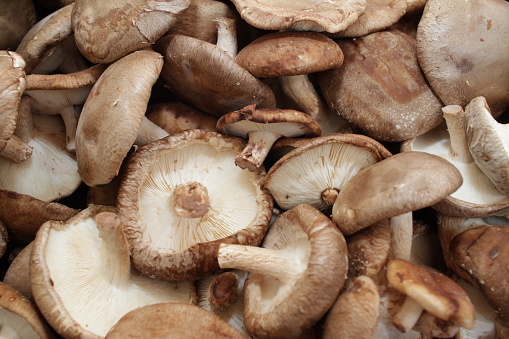Shiitake mushrooms are one of the easiest types of mushrooms to grow. Growing shiitakes at home is an economical way to enjoy fresh produce all year round.
The process for growing shiitakes includes gathering materials, inoculating logs with spores, and maintaining proper humidity levels.
Shiitakes should be grown in a moist climate with temperatures between 60 and 70 degrees Fahrenheit.
To begin growing shiitake mushrooms, gather your supplies:

- Shiitake mushroom plugs
- Tools for drilling holes in logs
- Chicken wire or an old screen door to use as a bottom for your outdoor growing container
- Pruners or sharp knife for harvesting mushrooms
- Aged hardwood logs e.g fruit trees, willow, cottonwood, oak, and maple
- A garden trowel
- A 7.5-watt ultraviolet grow light (optional)
- Cheese wax
How to Grow Shiitake Mushrooms Outdoors: A Step-By-Step Guide
1. Drill Holes in the Logs
Ideally, you should plan to drill holes in logs within six weeks of them being cut from living trees. Drill a row of holes along the length of a log, spacing them 4 to 6 inches apart.
Below that, drill another row of holes spaced 4 to 6 inches apart, alternating where you drill so that you end up with a diamond pattern. Continue around the entire log. Repeat with remaining logs.
After you drill the holes, it’s important to immediately move to steps 2 and 3.
2. Inoculate the Logs
This is filling the holes with either the sawdust or plug spawn, making sure it is flush with the log.
You'll need to inoculate the logs with spores 5 months before you plan on harvesting shiitakes, so begin this process at the same time you plant your garden.
Find healthy-looking trees by searching for ones that are growing in open areas with direct sunlight.
Make your inoculation site by peeling back the bark on one side of the trunk to expose healthy phloem tissue (inner bark).
You need to drill and fill your logs with spores in the early spring and harvest them in the fall. Drill 6mm holes 6 cm away from each other, and 6 cm deep. Each hole should contain about 0.5 ccs of spores.
The easiest way to do this is with a proper spore syringe, but you can also use a bb gun with the tip cut off. Just insert the tip into your drilled hole, and pull back on the plunger to dispense spores.
Find a shady area of your garden that gets plenty of rainfall. Keep your inoculated logs stacked together and covered with plastic or melted wax to keep them moist for a week after you drill the holes.
3. Brush Holes with Melted Wax
To melt the wax, fill a Mason jar half-full with wax beads or granules. Place the jar in a pot and carefully pour enough hot water into the pot around the jar so that it reaches one-quarter of the way up the jar. The heat from the hot water will melt the wax.
Brush each hole in your logs that’s been filled with spawn with melted wax to seal it. Use the wax to paint over any scarred places on the logs to keep out contaminants and insects.
4. Arrange Your Logs
For the first six months, lay the logs down to allow the spawn to run through the entire log. After six months, stand your legs up and lean them against a tree.
5. Keep the Logs from Drying Out
After a week, remove the plastic from each log and put it in a shady area. Keep logs wet until mushrooms sprout from your inoculated holes, which will take 5 to 8 months.
Regular rainfall should be sufficient, but you may need to water your logs during dry periods.
6. Harvesting
If inoculated in February, logs typically fruit in the late summer or fall the first year. In the second year, mushrooms will likely appear in the spring and again in the fall.
Use a sharp knife to cut the mushrooms off flush with the log, leaving the root system intact. After harvesting, immediately put the logs underwater for a few months to prevent the growth of mold and bacteria on the cut portion.
7. Don't Leave Your Logs Outside Too Long
Don't leave your logs outside too long once you've harvested all your mushrooms, as they will become waterlogged and rot if left in place for more than two weeks.
Once it has cooled down for winter, stack your log outside. The mycelium will go dormant and wait out the winter
In the spring, there should be little mushrooms popping up all over that you can harvest to make your next batch of logs!
8. Transplant Your Logs to a New Spot Every Year
Every two years or so, transplant your logs to a new spot and let them regrow in that area.
This is particularly important if you're using the same location for multiple years in a row, as it will deplete the soil of nutrients and eventually lead to infections and problems with production.
Tips to maintaining your shiitake garden:
- Logs can be wrapped in chicken wire to prevent rodents from chewing on them.
- Make sure the compost pile and garden remain moist during this process, but not soaking wet.
- Re-stack logs every 2 days so they don't dry out through exposure to sun and wind
- Keep humidity levels at between 95-98% or they will die off. The easiest way to do this would be to grow them inside a terrarium
- A 7.5-watt ultraviolet grow light will help maintain proper humidity levels in your terrarium, which should be between 95 and 98 per cent
- Be sure to mist the inside of your terrarium daily, or place a shallow tray underneath your terrarium to collect rainwater
- If a rogue mushroom appears, remove the log from the rest
Conclusion:
Having a shiitake garden can be a great way to save and grow your own mushrooms to last you through the year.
Once your logs are inoculated, all that's required is for you to keep them moist and harvest regularly!
Please leave a comment if you have any questions, suggestions, or would like something clarified. Thanks!

